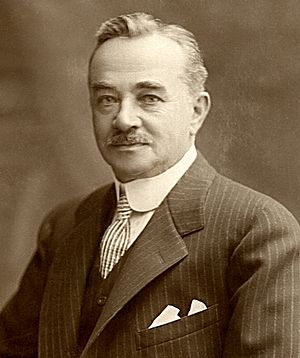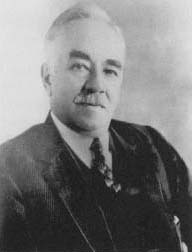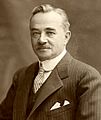Milton S. Hershey facts for kids
Quick facts for kids
Milton S. Hershey
|
|
|---|---|

Hershey in 1910
|
|
| Born | September 13, 1857 Derry Township, Pennsylvania, United States
|
| Died | October 13, 1945 (aged 88) Hershey, Pennsylvania, United States
|
| Resting place | The Hershey Memorial, Hershey Cemetery, Laudermich Road, Hershey, Pennsylvania, U.S. Section Spec-Her, Lot 1. |
| Nationality | American |
| Other names | The Chocolate King |
| Education | Started school at 6 years old and finished through fourth grade |
| Occupation | Confectioner, businessman, philanthropist |
| Known for | The Hershey Company-Founder, Hershey Bar, Hershey, Pennsylvania-founder/planner, Hershey Cemetery |
| Net worth | approx. $10 billion USD |
| Spouse(s) |
Catherine "Kitty" Elizabeth Sweeney
(m. 1898; died 1915) |
| Children | none |
Milton Snavely Hershey (September 13, 1857 – October 13, 1945) was an American businessman and philanthropist. He is famous for founding Hershey's, one of the biggest chocolate companies in the world. He also created the town of Hershey, Pennsylvania, and started a school for orphaned children.
Hershey was born on September 13, 1857, in Derry Township, Pennsylvania. He learned how to make candy at a young age.
In 1887, Hershey started the Lancaster Caramel Company. He made many different kinds of caramels. Later, he became very interested in chocolate after visiting the Chicago World's Fair.
He began building his chocolate factory in 1903. This factory grew to be the largest chocolate company in the world. Hershey also helped the U.S. military during World War II by making special chocolate bars for soldiers.
Milton Hershey was married to Catherine Sweeney from 1898 until her death in 1915. He passed away on October 13, 1945, at 88 years old, in the town named after him.
Contents
- Milton Hershey's Early Life and Business
- The Hershey Chocolate Company
- Building a Community: Hershey, Pennsylvania
- Milton Hershey's Generosity
- A Close Call: The Titanic
- Hershey's Role in World War II
- Milton Hershey's Personal Life and Death
- Milton S. Hershey's Famous Sayings
- Images for kids
- See also
Milton Hershey's Early Life and Business
Milton Hershey was born in rural Pennsylvania. He started school when he was six years old and finished fourth grade. He learned the candy-making business as an apprentice.
He tried to start candy businesses in Philadelphia and New York City, but they didn't succeed. He learned a lot from these early attempts.
The Lancaster Caramel Company
In 1883, Hershey returned to Lancaster, Pennsylvania. He borrowed money to start the Lancaster Caramel Company. This company quickly became very successful. He used a special caramel recipe he had learned on his travels.
Hershey found that selling caramels in large amounts worked best. An English visitor loved his candies and placed a huge order for Britain. This helped Hershey pay off his debts and buy more ingredients.
By the early 1890s, the Lancaster Caramel Company was very big. It had over 1,300 workers in two factories. After visiting the World's Columbian Exposition in Chicago, Hershey became fascinated with chocolate.
He decided to take a big risk. In 1900, he sold the Lancaster Caramel Company for one million dollars. He wanted to focus entirely on making chocolate.
The Hershey Chocolate Company
With the money from selling his caramel company, Hershey bought farmland. This land was about 30 miles (50 km) northwest of Lancaster, near where he was born. He chose this spot because he needed a lot of fresh milk to make good milk chocolate.
At that time, milk chocolate was a luxury. Hershey wanted to make it affordable for everyone. He worked hard to create his own recipe for milk chocolate.
The very first Hershey bar was made in 1900. Later, Hershey's Kisses were created in 1907. The Hershey's Bar with almonds came out in 1908.
On March 2, 1903, Hershey started building his chocolate factory. It was finished in 1905. This factory was designed to make chocolate using the newest mass production methods. Hershey’s milk chocolate quickly became the first nationally sold product of its kind.
The factory was built in the middle of dairy farms. This meant Hershey had easy access to fresh milk. He used this milk to make high-quality milk chocolate for everyone.
Building a Community: Hershey, Pennsylvania
Milton Hershey wanted to create a special place for his workers. He believed that good living conditions made for better workers. He built a town around his chocolate factory.
This town was comfortable and affordable for his employees. It had houses, businesses, churches, and good transportation. Hershey also built fun places for his workers, like Hersheypark, which is now a popular amusement park.
He was one of the first to use the idea of "Taylorism." This meant that workers who did more should earn more money. Hershey cared deeply about his product's quality and his workers' well-being.
Milton Hershey's Generosity
Milton Hershey and his wife, Catherine, did not have any children. Because of this, they decided to help other children. In 1909, they started the Hershey Industrial School. This school was for orphaned children.
In 1918, Hershey gave most of his money and control of his company to a special fund. This fund, called the Milton Hershey School Trust, was created to benefit the school. This trust still controls the Hershey Company today.
In 1951, the school was renamed the Milton Hershey School. The trust also owns other properties, like the Hotel Hershey and Hersheypark. Hershey was very proud of how the school, the town, and his business grew.
Other Charitable Works
- In 1935, Hershey started the M.S. Hershey Foundation. This foundation helps provide educational and cultural opportunities for people living in Hershey.
- The foundation supports the Hershey Story Museum, Hershey Gardens, the Hershey Theatre, and the Hershey Community Archives.
- In 1963, the Milton Hershey School Trust helped create the Penn State Milton S. Hershey Medical Center. This hospital is a teaching hospital and was a gift to the people of Pennsylvania.
A Close Call: The Titanic
In 1912, Milton and Catherine Hershey had tickets to travel on the famous RMS Titanic. This was the ship's first trip across the ocean. However, they had to cancel their plans at the last minute.
Milton Hershey had important business matters that needed his attention. So, they booked passage on an earlier ship, the SS Amerika. A copy of the check Hershey wrote for his Titanic deposit is now in the Hershey Story Museum.
Hershey's Role in World War II
During World War II, the Hershey Chocolate Company played a big part in helping the U.S. military. They made special chocolate bars for soldiers. These were called Ration D Bars and Tropical Chocolate Bars.
The army had strict rules for the Ration D Bar:
- It had to weigh 1 or 2 ounces (28 or 57 g).
- It had to stay solid even in hot temperatures (over 90 degrees).
- It had to taste just "okay" so soldiers wouldn't eat them too quickly.
After a while, the army was very impressed with how well the Ration D Bar worked. They asked Hershey to make the Tropical Chocolate Bar. This bar tasted better but was still very durable. It was designed not to melt in hot, tropical weather.
Between 1940 and 1945, over three billion of these special chocolate bars were made. At the end of the war, the Hershey plant was making 24 million ration bars every week! The company received five Army-Navy 'E' Production Awards for their excellent work. The Hershey factory even made parts for tanks during the war.
Milton Hershey's Personal Life and Death
Milton Hershey married Catherine Elizabeth "Kitty" Sweeney on May 25, 1898. She was from Jamestown, New York. They did not have any children.
Catherine Hershey passed away on March 25, 1915, due to an illness. In 1919, Milton Hershey moved her body to the Hershey Cemetery. This cemetery was built by Hershey himself. His mother and father were also buried there later.
Death and Legacy
Milton Hershey died from pneumonia in Hershey Hospital on October 13, 1945. He was 88 years old. He is buried in the Hershey Cemetery next to his wife.
At the Milton Hershey School, there is a bronze statue of him holding an orphan boy. The words below it say: "His deeds are his monument. His life is our inspiration."
September 13, Milton Hershey's birthday, is also known as International Chocolate Day. In 1995, the United States Postal Service honored him with a 32-cent stamp. This stamp recognized him as a great philanthropist.
Milton S. Hershey's Famous Sayings
- "My best advice to you is - when you tackle a job stick to it until you have mastered it."
- "I’ll stake everything on chocolate."
- "If I rest, I’ll rust."
Images for kids
See also
 In Spanish: Milton Snavely Hershey para niños
In Spanish: Milton Snavely Hershey para niños




